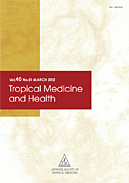Volume 32, Issue 1
Displaying 1-6 of 6 articles from this issue
- |<
- <
- 1
- >
- >|
Original article
-
2004 Volume 32 Issue 1 Pages 1-4
Published: 2004
Released on J-STAGE: July 30, 2004
Download PDF (36K) -
2004 Volume 32 Issue 1 Pages 5-14
Published: 2004
Released on J-STAGE: July 30, 2004
Download PDF (926K) -
2004 Volume 32 Issue 1 Pages 15-19
Published: 2004
Released on J-STAGE: July 30, 2004
Download PDF (55K) -
2004 Volume 32 Issue 1 Pages 21-26
Published: 2004
Released on J-STAGE: July 30, 2004
Download PDF (52K) -
2004 Volume 32 Issue 1 Pages 27-30
Published: 2004
Released on J-STAGE: July 30, 2004
Download PDF (33K) -
2004 Volume 32 Issue 1 Pages 31-36
Published: 2004
Released on J-STAGE: July 30, 2004
Download PDF (359K)
- |<
- <
- 1
- >
- >|
